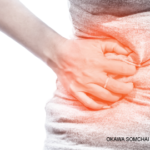Emergency department evaluation did not reveal acute abdomen or signs of peritonitis or sepsis. Computerized tomography (CT) of the abdomen with contrast confirmed pneumoperitoneum and revealed intramural air in the ileum without obvious gastrointestinal perforation (see Figure 2).2 Surgical consultation was obtained.
Given the patient’s history of partial colectomy and the degree of pneumoperitoneum, the consulting surgeon decided exploratory laparotomy was indicated to rule out occult gastrointestinal perforation. Exploratory laparotomy revealed no evidence of gastrointestinal perforation, peritonitis or other significant pathology. The abdomen was closed, and the patient had an uneventful postoperative recovery.
Discussion
Different proposed theories regarding PCI pathophysiology include: 1) mechanical, 2) pulmonary, 3) bacterial and 4) immune system dysfunction.7-9 The interconnection between these different mechanisms cannot be ignored.
The mechanical theory describes the importance of increased intraluminal pressure that breaches the normal mucosal barrier, leading to enhanced gut permeability and migration of gas from the gastrointestinal cavity into the intestinal wall.3,8
The pulmonary theory describes the significance of underlying lung diseases, such as chronic obstructive pulmonary disease, asthma and interstitial pneumonia, which can lead to alveolar rupture causing mediastinal emphysema tracking caudally to the retroperitoneum and into the bowel mesentery.3,8
The bacterial theory states that bacteria penetrate the intestinal mucosal wall barrier and produce alpha glucosidase, contributing to flatulence by suppressing carbohydrate absorption in the colon and leading to the generation of gas.3,8
Connective tissue diseases, such as systemic sclerosis (SS) and systemic lupus erythematosus (SLE), have also been postulated to cause intestinal mucosal atrophy and defects within the mucosa leading to the formation of cysts in the intestinal submucosa.9
PCI usually results from an underlying condition, likely due to different pathophysiological processes. Unlike acute gastrointestinal conditions associated with this condition, PCI can be chronic and often asymptomatic.
The pathogenesis of PCI in various rheumatic conditions, however, is unclear. CT imaging is the generally accepted modality to establish a diagnosis of PCI and has greater sensitivity for diagnosis than plain film or ultrasound imaging.2,3
Pneumoperitoneum may be associated with PCI as a benign asymptomatic condition after the rupture of intramural subserosal air-containing cysts without true intestinal wall perforation.2-5 For patients with pneumoperitoneum, a clinical assessment is paramount. If acute pathology is suspected, such as bowel perforation, peritonitis or necrotic bowel, then urgent surgical intervention is warranted.3 In the absence of convincing clinical signs, clinical monitoring is warranted and may save the patient from undergoing an invasive procedure.



